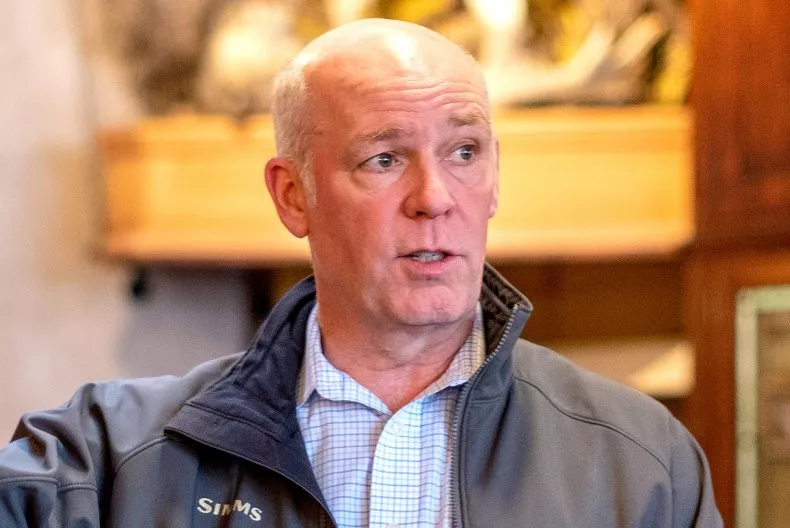Republican Montana Governor Greg Gianforte is calling on Democratic support in his state’s legislature to pass a bill offering $1,200 per child in tax credits to lower-income families.
The discontinuation of national child tax credits originally approved by Congress as part of the American Rescue Plan legislation introduced during the COVID-19 pandemic led to an increase of 3.7 million children in poverty across the country—a 41 percent increase between December 2021 and January 2022, according to a study published last year by the Columbia University Center on Poverty and Social Policy.
The 2024 budget proposal introduced by President Joe Biden, who on Tuesday announced his reelection campaign, would restore credits back to their 2021 amount and raise the formerly approved amount to $3,000, an increase of $1,000. Parents with children under 6 years old would receive a proposed $3,600.
Montana’s plan as outlined in the now defunct House Bill 268 originally introduced January 17 would have offered credits to families with incomes up to $50,000 for each child aged 5 or younger.
It would have cost the state approximately $33 million annually if it passed. But in somewhat of a twist, five of seven Democrats on Montana’s House Appropriations Committee—joined in opposition by nine of 16 Republicans—torpedoed the bill.
The bill could have advanced if all Democrats were on board. It was eventually tabled in committee on February 23.
“The governor and hardworking families are disappointed the legislature tabled his pro-family, conservative child tax credit for low-income and middle-class Montana families,” Gianforte’s Deputy Communications Director Brooke Stroyke told Newsweek in an email.
“High inflation and rising prices are making it harder for them to make ends meet as they pay for childcare, health care, food, clothing and diapers for their kids, and the child tax credit would make a big difference for them.”
A poll published last fall by Zero to Five Montana, a statewide early childhood education and care advocacy organization, found overwhelming support for early childcare investment—including 75 percent of respondents who said Montana’s state government should actively help reduce costs for parents, and 93 percent who said childcare costs are “burdensome.”
House Minority Leader Kim Abbott, a Democrat, said after the bill’s floundering that her side of the aisle was using appropriations committee votes as negotiation leverage for legislative action on housing, childcare and mental health programs.
“I think the folks in appropriations are taking up some space right now on proposals because we have priorities,” Abbott said, according to the Montana Free Press. “If people are expecting our votes to move priorities, even if we like them, we need our priorities funded too.”
Another Montana House Democrat, Emma Kerr-Carpenter, said one frustrating provision inserted into the bill was a work requirement.
“If it came back without strings attached, I’d be for it, or I’d be a lot more for it,” she said. “And also if I knew it wasn’t going to be used as some sort of shield to avoid doing other things for families.”
Gianforte reiterated his commitment to the legislation when asked during an April 6 press conference about its potential passing, calling childcare “the workforce behind our workforce” and allowing parents to decide how to use the dollars.
“The Minority Leader cited three priorities: housing, childcare and mental health to get her support for our child tax credit,” Gianforte said. “The Republicans in the legislature are making progress on all three of these priorities, and it’s now time for the minority leader to step forward and support working families in Montana by supporting our child tax credit.”
Nothing is dead “and we still have time on the clock,” he added regarding the bill’s chances of passage.
Last month, Montana lawmakers passed bills to decrease the state’s top income tax rate from 6.5 percent to 5.9 percent. Also passing was a $500 property tax rebate to homeowners for their primary residence in 2023 and 2024, in addition to rebates up to $1,250 for each Montana income taxpayer.
There were also cuts to the business equipment tax and changes to the corporate tax code and capital gains tax rates that now make Montana’s rate the fourth lowest in the nation.
More states evaluating own child tax credits
Aidan Davis, state policy director for the Institute on Taxation and Economic Policy (ITEP), told Newsweek that a “major trend” in the United States involves the momentum of state-level child tax credits.
Aside from Montana, the states of Arizona, Maryland, Massachusetts, Minnesota and New Jersey have all expressed either creating a system or improving upon credits already in existence. Of those states, the only one led by a Republican governor is Montana.
“CTCs [Child tax credits] boost the after-tax incomes and economic security of a diverse group of families but, when designed well, can be particularly important for Black, Hispanic, Indigenous, and other people of color confronting economic hardship created by systematic racism,” Davis wrote in a September 2022 report.
Lawmakers in both New Mexico and Maryland have already signed off on legislation boosting existing credits, she added. Debates on the topic have occurred in other states including Colorado, Connecticut, Hawaii, Illinois, and New York, as well as Washington, D.C.
“The state-level additions of child tax credits and overall improvements to these credits are important and have the ability to meaningfully move the needle on child poverty and the regressive nature of state and local tax systems,” Davis said.
“But federal policy, like the extension of the 2021 federal child tax credit per Biden’s annual budget proposal, would provide the broadest child poverty reduction across the country. In that scenario, states could then build upon the federal credit and achieve their goals with a smaller state credit.”




